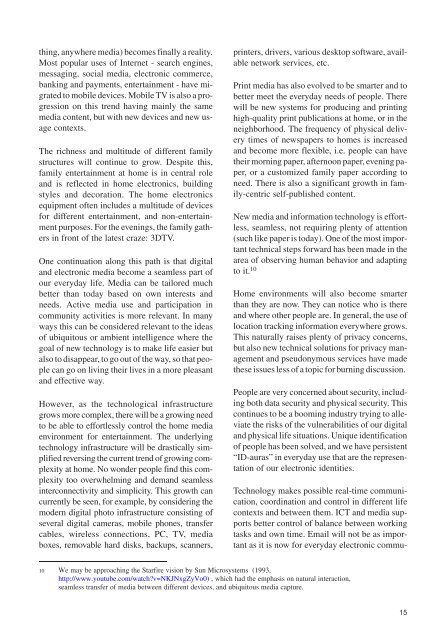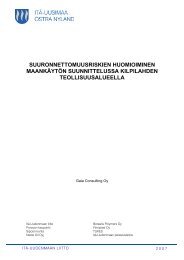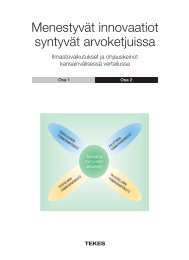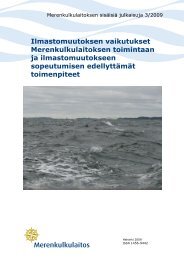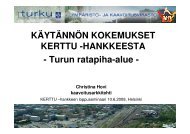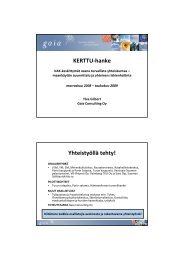227/08 Social challanges s the basis for foresight - Gaia
227/08 Social challanges s the basis for foresight - Gaia
227/08 Social challanges s the basis for foresight - Gaia
You also want an ePaper? Increase the reach of your titles
YUMPU automatically turns print PDFs into web optimized ePapers that Google loves.
thing, anywhere media) becomes finally a reality.<br />
Most popular uses of Internet - search engines,<br />
messaging, social media, electronic commerce,<br />
banking and payments, entertainment - have migrated<br />
to mobile devices. Mobile TV is also a progression<br />
on this trend having mainly <strong>the</strong> same<br />
media content, but with new devices and new usage<br />
contexts.<br />
The richness and multitude of different family<br />
structures will continue to grow. Despite this,<br />
family entertainment at home is in central role<br />
and is reflected in home electronics, building<br />
styles and decoration. The home electronics<br />
equipment often includes a multitude of devices<br />
<strong>for</strong> different entertainment, and non-entertainment<br />
purposes. For <strong>the</strong> evenings, <strong>the</strong> family ga<strong>the</strong>rs<br />
in front of <strong>the</strong> latest craze: 3DTV.<br />
One continuation along this path is that digital<br />
and electronic media become a seamless part of<br />
our everyday life. Media can be tailored much<br />
better than today based on own interests and<br />
needs. Active media use and participation in<br />
community activities is more relevant. In many<br />
ways this can be considered relevant to <strong>the</strong> ideas<br />
of ubiquitous or ambient intelligence where <strong>the</strong><br />
goal of new technology is to make life easier but<br />
also to disappear, to go out of <strong>the</strong> way, so that people<br />
can go on living <strong>the</strong>ir lives in a more pleasant<br />
and effective way.<br />
However, as <strong>the</strong> technological infrastructure<br />
grows more complex, <strong>the</strong>re will be a growing need<br />
to be able to ef<strong>for</strong>tlessly control <strong>the</strong> home media<br />
environment <strong>for</strong> entertainment. The underlying<br />
technology infrastructure will be drastically simplified<br />
reversing <strong>the</strong> current trend of growing complexity<br />
at home. No wonder people find this complexity<br />
too overwhelming and demand seamless<br />
interconnectivity and simplicity. This growth can<br />
currently be seen, <strong>for</strong> example, by considering <strong>the</strong><br />
modern digital photo infrastructure consisting of<br />
several digital cameras, mobile phones, transfer<br />
cables, wireless connections, PC, TV, media<br />
boxes, removable hard disks, backups, scanners,<br />
printers, drivers, various desktop software, available<br />
network services, etc.<br />
Print media has also evolved to be smarter and to<br />
better meet <strong>the</strong> everyday needs of people. There<br />
will be new systems <strong>for</strong> producing and printing<br />
high-quality print publications at home, or in <strong>the</strong><br />
neighborhood. The frequency of physical delivery<br />
times of newspapers to homes is increased<br />
and become more flexible, i.e. people can have<br />
<strong>the</strong>ir morning paper, afternoon paper, evening paper,<br />
or a customized family paper according to<br />
need. There is also a significant growth in family-centric<br />
self-published content.<br />
New media and in<strong>for</strong>mation technology is ef<strong>for</strong>tless,<br />
seamless, not requiring plenty of attention<br />
(such like paper is today). One of <strong>the</strong> most important<br />
technical steps <strong>for</strong>ward has been made in <strong>the</strong><br />
area of observing human behavior and adapting<br />
to it. 10<br />
Home environments will also become smarter<br />
than <strong>the</strong>y are now. They can notice who is <strong>the</strong>re<br />
and where o<strong>the</strong>r people are. In general, <strong>the</strong> use of<br />
location tracking in<strong>for</strong>mation everywhere grows.<br />
This naturally raises plenty of privacy concerns,<br />
but also new technical solutions <strong>for</strong> privacy management<br />
and pseudonymous services have made<br />
<strong>the</strong>se issues less of a topic <strong>for</strong> burning discussion.<br />
People are very concerned about security, including<br />
both data security and physical security. This<br />
continues to be a booming industry trying to alleviate<br />
<strong>the</strong> risks of <strong>the</strong> vulnerabilities of our digital<br />
and physical life situations. Unique identification<br />
of people has been solved, and we have persistent<br />
“ID-auras” in everyday use that are <strong>the</strong> representation<br />
of our electronic identities.<br />
Technology makes possible real-time communication,<br />
coordination and control in different life<br />
contexts and between <strong>the</strong>m. ICT and media supports<br />
better control of balance between working<br />
tasks and own time. Email will not be as important<br />
as it is now <strong>for</strong> everyday electronic commu-<br />
10 We may be approaching <strong>the</strong> Starfire vision by Sun Microsystems (1993,<br />
http://www.youtube.com/watch?v=NKJNxgZyVo0) , which had <strong>the</strong> emphasis on natural interaction,<br />
seamless transfer of media between different devices, and ubiquitous media capture.<br />
15


